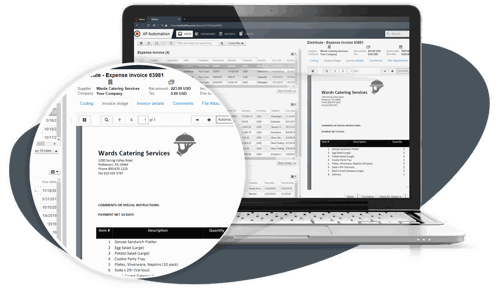Invoice Management: What is it & Why Should it be Automated?
What is invoice management?
Invoice management is the process of making sure your suppliers and vendors get paid on time, the transaction is recorded on the books, and goods and services are received. Typically invoice management is handled by the AP department at your company, but the invoices, purchase orders (POs), and receipts often touch many handlers during the process. Invoice management is often synonymous with invoice processing.
Why is invoice management important?
It’s essential for companies to have a tight invoice management process because suppliers and vendors don’t appreciate not getting paid in a timely manner. Further, accidentally paying a vendor twice for a six-figure contract is probably not going to go over very well with your head of finance. Good invoice management is accountability in action for money going in and out of your company.

What are the different types of invoices?
Is an invoice just an invoice? No—in fact, there are many different types of invoices.
Standard invoice — The most common invoice type which denotes a list of services performed or goods sent and their subsequent costs.
Debit invoice — Received before a standard invoice, the debit invoice, or debit note, informs a buyer of what they owe for services or goods received.
Credit invoice — This type of invoice is a document that lists discounts, refunds, or corrects an invoice error (usually due to human error.)
Mixed invoice — An invoice that combines debit invoice items and credit invoice items.
Sales invoice — An invoice from a business sent to a client which lists the items sold, how many, and how much they cost.
Purchase invoice — Also known as a sales invoice, purchase invoices inform what was sold, the quantity, and the price.
E-invoice — An electronic invoice, often used as a catch-all phrase to describe AP-related documents sent and received online.
Recurring invoice — Just what it sounds like, this type of invoice is issued on a regular basis.
Interim invoice — For very large projects, these types of invoices allow purchasers to split up the payments to suppliers over time.
Pro forma invoice — Pro forma invoices are ballpark estimates sent by suppliers and vendors for how much their services or goods will cost.
Expense report — An invoice type filled out by employees, not vendors or suppliers, for reimbursement on purchase items, often due to business travel or other work-related expenses.
Timesheet invoice — A type of invoice used by people who work at an hourly rate.
Commercial invoice — A special type of invoice specifically for international sale of goods and services.
Manual invoice — The opposite of an automated invoice, data must be manually entered in the AP system of spreadsheets for tracking and payment.
Past due invoice — Relationship-damaging invoice situation between a supplier and a business, usually occurs due to poor invoice management practices or lack of automation.
Final invoice — The final invoice is the last invoice that is sent by a supplier or vendor for goods or services sold and it includes exact, not estimated amounts and figures.

What are PO & Non-PO Invoices? What are the differences?
Non-PO invoices are not pre-approved beforehand, and therefore need to go through a different workflow than the standard PO process. PO invoices are pre-approved during the requisition process which means they can be processed quickly given there are no discrepancies between the PO and receipt. It is possible to automate both PO and Non-PO invoices. Read more about the differences between PO and Non-PO invoices.
What are the steps of invoice processing and the common invoice management best practices to know?
The steps of invoice processing typically include the following:
- Intake invoice data into the AP system
- Match invoice to PO to receipts
- Approve or reject invoices
- Authorize and submit payment
- Pay suppliers/vendors for goods or services received
- Closeout invoice/archive invoices for record-keeping and an audit trail
But in each of these steps, there are many other automation tasks that also occur. Read more about data extraction here.
Some common invoice management best practices you should consider:
- Manage invoices by using an automated AP system that matches invoice to PO for you and flags duplicates.
- Input PO data into the system as close as possible to the time as the documents are received.
- Have backup approvers for when people are on holiday so there isn’t a hold-up in the AP process.
- Finish payment processing early and often to try to take advantage of early payment discounts.
- Prioritize invoice management by due dates.
- Move away from paper invoices if possible.

What are the most common mistakes in invoice management?
Some of the most common things that can go wrong in invoice management are easy to alleviate with the right AP solution. For example, duplicate payments or fraudulent invoices can easily be flagged. Other things that can go wrong include not paying a supplier or vendor on time, which strains the relationship between the vendor and the employee, and could even end the relationship altogether, and also lead to additional losses. Probably the most common mistake in invoice management is inaccurate manual data entry due to human error, which can happen easily when automation is not in place. And the final offender, a lost or missing invoice!
What is an invoice management system?
An invoice management system is a system that helps you get your suppliers and vendors paid on time for goods and services received to run your business. Invoice management systems ensure financial accountability, reduce fraud, and spread out AP-related tasks among budget holders and other employees.
What are the benefits of automating invoice management?
If you’re into saving time, which most of us are, Accounts Payable automation solutions can match POs to invoices to receipts, which means your employees don’t have to manually upload and relate these documents to one another, allowing them to allocate their time to other tasks. And it goes beyond just trading paper invoices for digital PDFs, as Artificial Intelligence and Machine Learning can pick up on patterns and routines in your invoice process to remove the need for any AP staff member to intervene along the invoices’ journey from receipt to payment.
And it’s not just time savings you’ll get when you automate invoice management, it’s also cost savings. With the volume of invoices processed, it’s actually quite common for duplicate payments to occur without this duplicate-flagging feature in place.
Because there can often be such a lag in the time it takes to pay suppliers, many companies miss out on early payment discounts, which are difficult to take advantage of without an automated invoice management solution in place. This is where BIG cost savings can come in. Read more about where you can save time and money with invoice processing automation.
How do you automate invoice management?
The biggest step to automating invoice management is to find the right AP solution, which will allow you to enter your business approval process workflow steps, rules, and appropriate parties for each type of invoice approval process. One of the first steps to automating invoice management is to document your lists of suppliers, types of invoices, contracts, approvers, and business rules and have all this handy so when you are ready to onboard an invoice management solution, you have already done the bulk of the work. As an example of information you’re looking to capture, you may want to flag any invoice above a certain amount, no matter the department it is coming from. There may be other rules like this that are more specific to your business you’ll want to document.
Why should you automate invoice management?
Besides having a near real-time look at your cash flow, paying suppliers on time, and reducing opportunities for fraud, automating invoice management is going to save a lot of time and money for your company. You can also keep your finance team leaner by bringing on an AP solution. Click here to read further about the touchless invoice process.
What specific tasks in invoice management do companies most commonly automate?
The most common tasks you can automate with invoice management solutions are: matching PO to invoice to receipt, automated data capture directly from AP-related documents, automated routing to specific approvers with automatic cost center coding during the AP process, flagging duplicates, and automatically releasing funds to suppliers once the workflow has been completed.
What are the signs that you need invoice management automation?
The most common signs you’re ready for invoice management automation include suppliers not getting paid on time, your finance team is stressed out, you don’t have a clear view of money going out or the overview is lagging months behind, and it may even be so bad that you aren’t getting parts in on time because you didn’t pay suppliers so business is halted or slowed.
How does Medius help its customers automate invoice management?
Medius is the leading AP solutions provider trusted by companies like Nissan, Xerox and PUMA. With Medius, Silver Eagle Distributors automated more than 90% of their invoices, and Lush Handmade Cosmetics digitized their AP process, moving away from paper billing and no longer files and pulls paper invoices from cabinets. Read more about invoice scanning here.

Why Medius for your invoice management software solution?
Not all accounting systems are created equally, and using an automated and timely invoice payment solution like Medius helps your business have a near real-time view of your finances. Medius is the leading AP solutions provider and utilizes AI to make AP easy, automated, and worry-free. It goes well beyond basic automation with advanced AI capabilities. With Medius you can take advantage of early payment discounts due to automation, avoid late fees, and finally say goodbye to duplicate invoices (or heaven-forbid fraudulent invoices!)
What’s more is that Medius easily integrates with leading ERPs (SAP, Microsoft Dynamics NAV, AX, 360 F&O, Infor M3, Oracle JD Edwards, etc.), has super fast implementation times, and also offers procurement, sourcing, and contract management solutions with AP and payment solutions.
If you’re in the market for invoice management software so you can automate AP and reduce manual error, click here to read more about our invoice management software solutions.






